Article
Transported Art:
19th-Century Italian Sculptures Across Continents and Cultures
Résumé
Le caractère international de la sculpture du 19e siècle a été négligé durant plusieurs années et, par conséquent, la recherche et les écrits du domaine de l’art ont presque totalement ignoré le fait que la plupart des sculptures italiennes du 19e siècle sont à présent répandues dans le monde entier. Cet article a pour but d’illustrer et de documenter des aspects spécifiques de la diffusion de la sculpture italienne en Amérique entre le milieu du 19e siècle et le début du 20e siècle. Parallèlement à ce flux d’œuvres d’art, de matériaux et de sculpteurs italiens en direction des Amériques, au cours des décennies chevauchant ces deux siècles, il y eut un mouvement inverse d’artistes américains s’intéressant à la sculpture italienne qui se rendaient à Rome, Florence, Gênes, Naples, etc. Grâce à ce double échange, la sculpture italienne obtint une forte influence et reconnaissance dans le monde entier. Cet article a également pour objectif d’instaurer un contexte interdisciplinaire pour la sculpture, afin de clarifier les connexions entre les facteurs sociaux, économiques et culturels.
Abstract
The international identity of 19th-century sculpture has been neglected for several years, and, as a result, artistic literature and research have almost completely ignored the fact that most 19th-century Italian sculpture is now spread all over the world. The purpose of this essay is to illustrate and document peculiar aspects of the diffusion of Italian sculpture in America between the mid-19th and early 20th century. Along with the flux of artwork, materials, and Italian sculptors to the Americas, over the decades straddling these two centuries there was an inverse movement of American artists (interested in Italian sculpture) to Rome, Florence, Genoa, Naples, and so on. Thanks to that double exchange, Italian sculpture became a strong, recognized influence worldwide. The aim of this paper is to establish an interdisciplinary context for sculpture, clarifying the connections with social, economic, and cultural factors.
1 This paper focuses on peculiar aspects of the wide international diffusion of Italian sculpture between the mid-19th and the early 20th centuries. During that period a huge quantity of artwork was moved from Europe to both North and South America. It consisted of sculptures of different kinds, made of different materials and realized by different Western artists (masters such as Bistolfi, Bourdelle, Calandra, CarriereBelleuse, Monteverde, Querol, Rodin, Story, Vela, and Ximenes, as well as hundreds of unknown or forgotten sculptors). Indeed, there was also an inverse influx of important young American sculptors in Europe (mainly in Paris, Rome, Munich, and Florence). Thanks to these two-way movements, Italian sculpture became influential throughout the world.
2 Nevertheless, the international identity of the 19th-century sculpture has been neglected in Italy for several years. For one, the sculpture of the 1800s was little studied by Italian scholars for almost all of the last century, compared to the historical avant-gardes. In addition, the links between Italian migrant communities and Italy have diminished since the 1930s. The main result of that neglect has been that Italian artistic literature, art exhibitions, and art research have almost completely ignored the fact that most 19th-century Italian sculpture is now spread all over the world.
3 Around the 1970s, critical perspectives on 19th-century sculpture started to change thanks to events such as the conference on neoclassicism held in London in 1971 (Comité International d’Histoire de l’Art 1973), the very important exhibition Metamorphoses in Nineteenth-Century Sculpture edited by Jeanne L. Wasserman (1975), and the 24th conference of the Comité International d’Histoire de l’Art in 1979 (Janson 1984). Moreover, in the last three decades, art historians have been involved in international conferences and exhibitions focusing on the relationship between Europe and America, especially on topics such as migration, art and culture, and political and economic exchanges.1
4 Between the end of the 20th and the beginning of the 21st century, this kind of research developed alongside the American studies on specific artists, territories, or contexts related to the presence of Italian art in North and South American countries (Pineda 1973; Soria 1993; Vignola 1996). Moreover, works such as those by Sandra Berresford (2007, 2009) or Rodrigo Gutiérrez Viñuales (2004), as well as the meetings of the Association of Significant Cemeteries in Europe (Felicori and Sborgi 2012), have recently proven that there is an international approach to studying 19th-century sculpture involving scholars from all over the world.
5 All these studies allow us to have a more comprehensive look at the global movement of sculpture between the 19th and the 20th century, which was very dynamic. In fact, French, English, Spanish, German, and American, not only Italian, sculpture developed outside its national boundaries during the 1800s. In such a broad Euro-American circulation, Italian sculpture held a very important role. For this reason, in this paper I will address cases related to the mobility of both Italian artwork and materials, as well as the movement of artists and artisans considered in terms of circulation of knowledge and techniques.
The Causes of the Wide American Diffusion of Italian Sculpture
6 In the 1800s, the historical capacity of sculpture to represent symbolically collective values and individual success acquired new momentum from the increase of bourgeois and republican ideals in Western society.2 The public spaces of the growing metropolis become the backdrop for the artistic representation of the new political and social course. In this framework, sculpture seems to be the favourite medium of both the private and public clients. Indeed, sculpture spreads throughout urban squares, buildings, gardens, and exhibitions but also in private residences and galleries (Sborgi 1984; Wasserman 1975).
7 Moreover, compared to paintings, drawings, and prints, sculpture needs a more complex system of processing, transport, and reproduction in order to be moved and diffused throughout different countries or regions. These social and technical aspects have to be considered in order to understand how and why a never-before-seen Atlantic circulation of sculptural artworks happened between the early 19th and early 20th century. We can say that a significant diffusion of sculpture in the 1800s needed: 1) an open and renewed urban society; 2) the political or collective will to build it as well as the financial capacity to do it; 3) a modern and efficient set of infrastructures for transportation and communication; 4) highly technical and artistically skilled people.
8 To make an extreme simplification, in the first half of the 19th century a lot of American countries gained independence from their European colonizers (especially Spain, France, and the United Kingdom). Obviously, these processes did not develop so linearly or easily, as is well demonstrated for example by Carmagnani (2003) and Codignola and Bruti Liberati (1999). Nevertheless, almost all North and South American countries had grown considerably, economically, demographically, and culturally, by the end of the century.
9 On the opposite side of the Atlantic ocean, Italian people above all were interested in joining the growing American societies for two main reasons. First of all, in the early decades of 1800s, the struggles for Latin American independence had much in common with the repression of Italian revolutionary aspirations; Italian intellectuals and insurgents as well as artists and politicians were pushed to leave Italy and reach Latin America. In that period, something similar was happening in the eastern United States, where the process of strengthening the Republic had already begun. Secondly, as the process of independence in Latin America strengthened, the ability of these countries to attract capital from abroad drew more and more Italian tradesmen and businessmen, alongside specialized art professionals such as architects, painters, and sculptors (Sartor 2006), to the Americas. That trend carried on (with highs and lows) until the end of the century, when the economic potential of both North and South America attracted a more consistent number of Italian families and non-specialized workers.
10 In this complex interweaving of social and economic dynamics, a new generation of people able to commission artworks emerged: while the new democratic institutions of America wanted to affirm their legitimacy and greatness through magnificent monuments, the enriched Italian migrants wished to prove their success and, at the same time, stress and remember their Italian roots. Among the private clients, not only Italian migrants but also American people commissioned artworks from Italian sculptors and architects.
11 One of the reasons for such international fortune of Italian sculpture is its strong connection to the Roman and Classic tradition. Indeed, the American institutions see in Italian contemporary marbles and statues the same magnificence of Ancient Rome and Greece. Admittedly, not all the initial orders of Italian sculptors and architects that American institutions made consisted of neoclassic works in marble (for example, those in the Capitol buildings in Washington and La Habana; in the first government buildings in the province of Entre Ríos, Argentina, in the Solis theatre in Montevideo, Uruguay, or in the municipal theatre in Santiago, Chile). While in the first decades of the 1900s the style of American buildings and public monuments was slowly evolving, the reproduction and the import of copies of the most important Italian classic masterpieces did not stop until the first half of the 1900s. For example, for the 1910 centennial celebrations of Argentinian independence, copies of Michelangelo and Canova were taken from Italy for exhibitions but also for the decoration of public places and buildings in Buenos Aires (Fig. 1). Even in the following decades, copies of the Pietà by Michelangelo or the Carità by Bartolini appeared in the cemeteries and hospitals of Latin America and Europe as well. Numerous marble and plaster objects were taken from Italy in order to be copied by students in new academies and art schools. Finally, at the end of the 1920s, Italy was exporting more marble objects than any other country.
12 Of course, the valuable technical ability of Italian sculptors and carvers represents another important reason for the success of Italian sculpture in America. This is more evident if we consider, for example, statistical data related to Italian emigration to Argentina in the second half of the 19th century. Analyzing the results of the research carried out by the Comitato della Camera Italiana di Commercio ed Arti in 1898, we find out that among the Italians crossing the Argentinian border between 1876 and 1896, 9,437 claimed to be an artist, compared to 5,041 Spanish artists and 2,611 French artists. The same statistics for 1896 show that the artists coming to Argentina from Italy represent 60 per cent of all European artists (Comitato 1898).3
13 If we look at the inverse movement of American artists to Italy, the importance of the technical ability of Italian artists emerges. Indeed, if we consider both the attractive power of the Italian artistic tradition and the advanced skills of Italian carvers and sculptors, we can understand why 19th-century North American sculptors were interested in Italian material and non-material culture. In fact, as demonstrated by research carried out by Guidi (1940), Savard (1983), and Wittmann (1952), a combination of religious, cultural, artistic, and economic factors drove Canadians and Americans to go to Italy (especially Rome and Florence, but also Naples, Bologna, Turin, Milan, Genoa, and other important cities of artistic heritage).
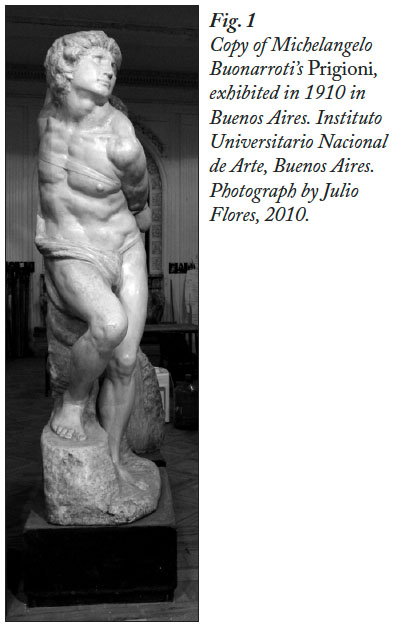 Display large image of Figure 1
Display large image of Figure 114 Let’s consider two examples about this North American interest in Italian sculpture: the first is related to technical and economic aspects, the second refers to cultural exchanges. Otto Wittmann highlights that around the mid-1800s in the United States, an artist like Harriet Hosmer
Moreover, in the same article, Wittmann—quoting from a paper by Willian Cullen Bryant of 1859—affirms that American artists “find Rome a better place for obtaining orders from their own countrymen than any of the American cities” (6). Bryant noted that in Rome men who would never have thought of buying a picture or statue at home, were infected by the contagion of the place the moment they arrived:
15 The second example, the one relating to cultural exchanges, regards eastern Canada especially. In the early 19th century lots of travellers reached Rome from the largest cities of Quebec; they were catholic bishops, men of letters, historians, and artists, and all of them were drawn to the common religious culture that connects Italy to Quebec. The first channels of diffusion for Italian sculpture in eastern Canada were, in fact, the Canadian Catholic Church, which, thanks to its parishes, asked Italian laboratories for artwork to decorate and furnish churches, convents, and cathedrals.
16 The ways in which artwork spread all over American cities, from south to north, are many and diverse. In some cases a sculptor would move from Italy to America to realize works in several regions, staying a few months or years once he was there. Otherwise the artist sent a draft of his final work from Italy, which would be realized in America by someone he trusted (usually an Italian carver). There were also cases in which finished sculptures were sent from Italy directly to the American location in which they would be erected. Nevertheless, a large quantity of semi-finished material (marble especially) left the Italian harbours bound for the Atlantic coasts and from there slowly on to the Pacific.
17 A robust and efficient system of transportation—consisting of reliable ships and train connections, as well as financial, insurance, and international trade networks—was necessary to allow this traffic both across the Atlantic ocean and throughout the vast American territories.
18 European investors had a great responsibility for the modern growth of Latin American countries. In fact, around the middle of the 19th century the big lack of infrastructure (ports, railways, roads, mail services, etc.) still represented a serious obstacle to the economic and cultural development of South American societies. With the progressive opening of Latin American governments to international trade and the subsequent investment of public and private capital in national and regional infrastructures, the gap between Latin America and other economic powers gradually decreased. Between the last quarter of the 1800s and the first decade of the following century, railways, but also telegraphic and telephonic networks, allowed international and inter-regional exchanges to increase, leading to the movement of a massive daily traffic of people, goods, money, and ideas (Carmagnani and Vangelista 2001).
19 At other times, American countries benefited from technological developments in transatlantic shipping. In Europe, Italian merchant vessels increased under the push of the English and French competition. However, the real business of that time was the transportation of people. Around the mid-19th century, shipyards of the Genoa area grew, thanks to the turnover from the transportation of people across the Atlantic ocean. As a consequence, people worked more and more on the improvement of ships. In the early 1860s the Genoese fleet included sailing ships that covered the Genoa-Mar del Plata route in nearly two months, carrying up to two hundred passengers. In the same period, the Société Génerale des Transports Maritimes of Marseille arranged a monthly transport service from Genoa to the Plata: thirty-five days with stops in Marseille, Barcelona, Gibraltar, and Brazil (Moricola 2008). The last quarter of the century was characterized by the development of steamships, and, from that moment, the Atlantic and the Mediterranean coasts were connected like never before.
Materials in Motion
20 In the previous section we saw how the diffusion of Italian sculpture in the Americas also meant the circulation of materials, artists (and, more generally, people), ideas, and capital: elements that together make up an international art system. For a long time, Italian art has widely been identified with marble, especially the white and fine marble from Carrara. Above all, Michelangelo, Bernini, and Canova were considered the height of the expression of classical aesthetic Italian values. Although the use of Italian marble was most widespread at the end of the 19th century, it was already used in America during the 18th century.
21 In fact, as Regina Soria (2002) remarked, in 1770, shipping of marble between the ports of Toscana (Livorno and Forte dei Marmi) and Baltimore was already at a considerable level. Although at this stage marble in the United States was used above all to realize components of buildings, there are also early examples of artistic uses—for example, the statue of Benjamin Franklin, made in 1789 by Francesco Lazzerini from Carrara. Soria cites a singular epistolary incident between Franklin and Antonio Del Medico, a rich owner of marble quarries in Carrara (Soria 2002: 59). In his letter, Del Medico suggested that his brother, working as a sculptor, would be able to produce numerous portraits for Franklin and other prominent U.S. men. In this context of connection to the North American elite, Carrara marble producers contrived a scheme in order to facilitate the export of the precious material. The Tuscan marble workers decided in fact to load ships with a good deal of marble blocks to be used as a ballast. Once the ship arrived in Baltimore, the blocks were sold to the American building companies and used to make simple housing components. Moreover, it is well known that the Washington Capitol was made largely of Carrara marble. When Benjamin Latrobe began to put his project into effect he realized that using imported fine and carved marble from Carrara would actually be cheaper than Maryland and Virginia marble which, in any case, would have to be worked by Italian stonemasons and sculptors (Soria 2002: 59-60).
22 We should not forget that Italian marble was used abroad in both artistic and non-artistic works. In the 19th century, marble—alongside of goods pertaining to the building and food industry—was one of the most important goods exported by Italy. In 1867, for example, foodstuffs, handicrafts, bricks, and cement were the main goods sent from the port of Genoa to Argentina. In the same year, 755,278 small blocks of marble (called “marmette”) and 12,852 crates of carved marble were sent to Argentina (Virgilio 1868).
23 In North America, as the Italian migration grew, Italian trade with the United States increased too. Between 1878 and 1906 exports from Italy increased from 1.34 per cent to 2.99 per cent in the United States market. There, as in Argentina, the most exported goods were raw materials like marble. However, 10 per cent of all exports was represented by processed or carved items, including fine artworks (Jaja 1907).
24 Although the use of local stone and marble in America increased greatly at the end of the 19th century, data referring to the Italian export of marble to America in the first three decades of the 20th century is still impressive. Franco Sborgi (2007) remarks that in 1917 (a dramatic year of war) 93,983 tons of marble were sent from Carrara; in 1918 the number of tonsexported was 212,307 whereas in 1926 the figure grew to 425,911 tons.4
25 This data finds a further confirmation when we look up trade statistics related to the import figures of Argentina (a country that shares with Brazil and the United States the greatest number of Italian immigrants) in the years 1930, 1931, and 1932. In that period, Italy was the first supplier of both marble slabs and blocks but also of marble and alabaster objects. Moreover, Italian bronze held an important role. While Italy, compared to France, Germany, and the U.S., sent fewer non-artistic objects in bronze and copper to Argentina, it was second only to France in the export of bronze artworks (Lucadamo 1933). For the governments of the western world, this trading of goods was just a matter of international business competition. The Comitato delle Esposizioni di Torino e Roma ordered a report in 1911 that strongly raised the problem relating to the lack of government support for Italian exports and productions in Brazil.
26 In her important work of 2002, Maria Elizia Borges documents a very interesting phenomenon featuring the province of Ribeirão Preto, three hundred kilometres north of São Paulo. Borges studied the close coincidence between the trading routes and the diffusion of Italian sculpture. As new production sites for coffee and other raw materials were developed, roads and railways linking cities, countryside, and harbours increased. Imported Italian marble began to travel along the railways toward the new cities where the increasingly rich new Brazilian aristocracy lived. In each thriving agricultural and commercial centre (Campinas, Amparo, Piracicaba, Araras), Italian workshops producing and selling sculpture and artworks appeared and prospered. Needless to say, the marble came largely from Carrara and production mainly revolved around decorative elements for civil and funerary architecture (Borges 2002).
27 The aforementioned trading activities were made possible because, since the mid-19th century, in all the most important commercial centres of America, hundreds of small but important Italian business started to work as artistic producers as well as importers. In La Habana, Cuba, between 1840 and 1940, nearly fifteen Italian marmolerias were engaged in the decoration of urban spaces, private buildings, and graves in the Colón cemetery (Labarca Delgado 2009: 112). In many cases, artworks were imported or sold along with goods of very different kinds. In Chile, for example, Italian companies trading in art objects and marble have existed since 1845, whereas in the early 1860s one of the most important Italian marmolerias also funded a crafts school for orphan boys in Santiago.5 Around the middle of the century, the city of Tacna (which is today in Peru) became one of the most important crossroads in the South Pacific area, as it is located between Peru, northern Chile, and western Bolivia. The Canepa company has been operating in Tacna since 1862 and its business ranges from farming and food shops to the importation of painting and sculptures from Carrara (Giuliani 2000).6
28 In addition to these hybrid companies, some Italian artists generated a real global trade in artworks realized by brilliant European sculptors: Giuseppe Livi and Giovanni Azzarini in Uruguay; Ulderico Tenderini in Peru; Carlo Nicoli in Argentina, Uruguay, and Mexico; Francesco Durini in Ecuador, Honduras, El Salvador, and Guatemala; the Piccirilli brothers in the eastern United States; Carli and Petrucci in Quebec: these are just a few examples of some artists who declared themselves sculptors, architects, contractors, builders, and tradesmen in marble and artworks. Many of them highlighted the fact that they had a studio in Carrara or Florence as a hallmark of their good work. They could import statues and masterpiece copies from Carrara to decorate cemeteries, churches, and buildings; they could contract masters like Leonardo Bistolfi, Pietro Tenerani, Giulio Monteverde, and many others for private and public assignments; they could realize statues, sculptures, even buildings by themselves; they could carve important monuments on behalf of American masters like Daniel Chester French (as in the case of Piccirilli), and so on.
Artworks and Artists in Motion
29 Italian sculpture spread all over American countries through four major channels of diffusion: architecture, public monuments, funerary sculpture, and exhibitions. For each one of these channels, the intervention of the sculptor always happened within a complex network of professionals involved in a wider global collaboration. A building or a public monument was rarely realized just using local talent and resources; more often there was a movement of objects and artists crossing Europe and both northern and southern America. Regarding funerary sculpture, the iconography of the statues and the symbology of the decorations were often influenced by the clients and dominant local culture, and so the original idea conceived by Italian artists transformed into hybrid compositions.
30 At the Universal Exhibitions, the best art pieces were often bought by the national or local governments to set up public collections. In this way, the art objects became a heritage of a different country and were then admired by the local people and copied by the students of art academies. In the second half of the 19th century, several countries called important international architects to construct their government buildings. Thus, a number of Italian sculptors were involved in forging the granitic iconographies of the new political status. Especially in the Plata area, between Argentina and Uruguay, over three decades straddling two centuries, a number of government buildings began to be erected with the contribution of famous Italian architects, sculptors, businesses, and laboratories.7 Alongside government architecture, while new churches were being built, American cities hosted the first museums, libraries, and modern theatres.
31 When the Piccirilli brothers (sculptors and architects) arrived in New York from Italy in 1888, they introduced in the country what the Kofflers have defined as “a first class sculpting system that America had mostly lacked” (Koffler and Koffler 2006: 12-13). A number of important monuments for Washington, DC, and hundreds of carvings (statues, reliefs, gargoyles, etc.) for New York City were made in the Piccirillis’ studio in the Bronx.
32 American theatres represent another type of building in which Italian arts hold a very important role (not only sculpture but also architectural planning, painting, and, of course, stage and music). When, around 1902, the architect Adamo Boari was commissioned to set up the National Theatre of Mexico (which later became the Institute of Fine Art), he went to the United States and Europe in order to teach himself about the latest innovations in that field. Already at that time he planned to engage sculptors such as Rodin, Bistolfi, and Troubetskoy to decorate the building, but later he chose the Italians Leonardo Bistolfi and Edoardo Rubino, the Spanish Augustin Querol, and the Hungarian Géza Maróti. Rubino may have been involved in that project thanks to his trusted carver Luciano Spirito, who in the same period was in Mexico to construct important public monuments entrusted to Enrique Alciati by the national government. In a letter from 1907 Rubino wrote to Alciati that he was waiting for some drawings by Boari.
33 Originally, the simplest external decorations were commissioned from some Mexican companies working in local marble quarries. Later on, lots of commissions were diverted to three big companies of Carrara, which contracted out decorative works to the most expert workshops, such as that of Carlo Nicoli. There, fine works were made by sculptors like Domenico Boni, who also created four plaster casts of female nudes for the Mexican theatre, which were carved in marble by the company Triscornia and sent to Mexico City in 1909 (Berresford 2007: 273-76). Boni was also the trusted collaborator of Augustin Querol.
34 In 1869, in Belèm, capital of the Brazilian state of Parà, the building of the Teatro da Paz began. While the model of inspiration for that project is the Teatro della Scala of Milan, after the renovation of 1904 the facade shows the influence of French art nouveau. However, lots of materials were used in the main foyer: Carrara marble for the staircase, fine iron from England for the doors, crystal from France for the mirrors and chandeliers. Several busts in marble by Genoese sculptor Achille Canessa representing Brazilian novelists were shipped from Italy.
35 In San José, Costa Rica, something similar happened with the erection of the National Theatre, which contains precious American wood but also scenic devices and decorative iron and glass from Europe. Several Italian companies worked on the decoration of the building, employing Italian painters, modellers, and plasterers. While those kinds of professionals left Italy to work in Costa Rica for a limited period (though sometimes they chose to settle there in order to start a career), more important sculptors were ordered to make and send statues directly from Italy. In the last years of the 1800s, sculptor Adriatico Froli, living in Carrara, was asked to make a statue representing Shakespeare as well as other allegories for the external parts of the theatre. Froli sent to San José allegoric statues and two sculptures representing Beethoven and Calderón de la Barca instead of that of Shakespeare. It might have been an oversight but it could also have been a deliberate replacement, considering that in the same period Froli was working on sculptures for monuments in Guatemala and California.
36 Furthermore in the field of commemorative public monuments, the dynamics of both contracting and implementation were sometimes not completely clear. For example, in Honduras, in 1882, Prime Minister Ramon Rosa engaged Francesco Durini to provide a series of public monuments for the new capital Tegucigalpa. Durini ensured the government that all the statues would be taken from Italy and placed in 1883. The most important monument would be consecrated to Francisco Morazan, father of the country’s independence. On the contrary, the big bronze equestrian statue (inaugurated in 1883 in Tegucigalpa) appeared to be made by a French sculptor (Léopold Morice) and did not represent Morazan but a French Napoleonic soldier. Along with the other statues (depicting the four seasons, three fathers of the nation, and an allegory of liberty realized by the Italian Luca Angelli), that monument arrived on a little island just off the pacific coast of Honduras, and in seventeen days reached Tegucigalpa on twenty wagons pulled by oxen.
37 In 1853, the government of Peru announced an international competition for a monument to Simon Bolívar, one of the leaders of Latin America independence. The selection of the sixty-four projects was made in Rome. The bronze equestrian statue was commissioned to the winner of the competition, Adamo Tadolini, while the runner up, Filippo Guaccarini, was asked to create the marble pedestal. By realizing that first equestrian icon in South America, Tadolini might have drawn inspiration from the famous portrait of Napoleon crossing the Alps painted by Jacques Luis David in 1800 (Castrillón Vizcarra 1991). The model made by Tadolini in Rome was sent to Munich to be cast in bronze, at the laboratory of the Müller company; later, the finished work was sent to Lima where it was officially inaugurated in 1859. The Müllers usually worked for clients from the United States and Latin America. In fact, the Caracas government asked them to produce a copy of the equestrian statue made by Tadolini for Lima (Fig. 2a, 2b, 3). Indeed, in 1874, a twin statue of Bolivar was inaugurated in the capital of Venezuela, and it was not a unique case of identical statues designed for two different countries. In the case we are going to see, a couple of identical monuments were constructed to strengthen the cultural and political link between two cities.
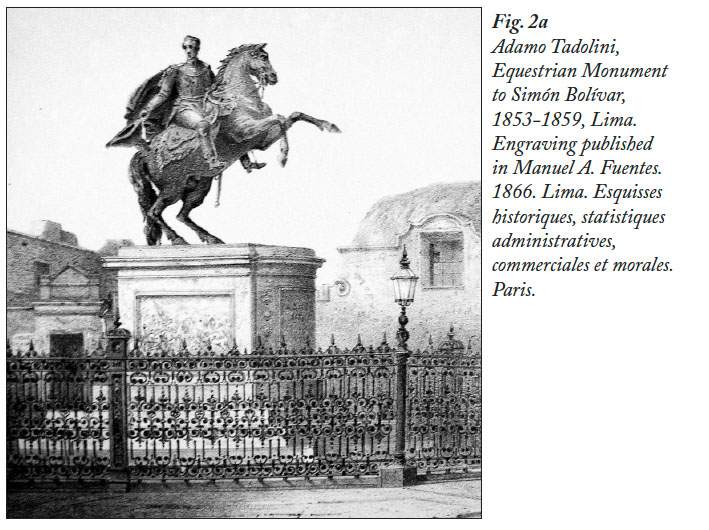 Display large image of Figure 2
Display large image of Figure 2 Display large image of Figure 3
Display large image of Figure 3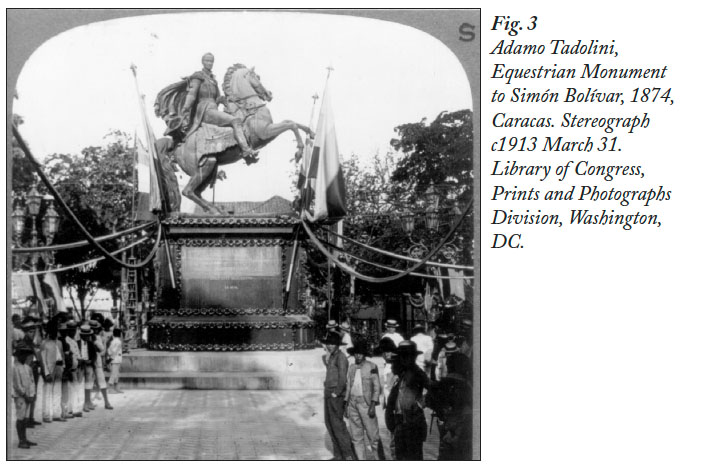 Display large image of Figure 4
Display large image of Figure 438 In 1922, the Italo-Argentinian Chamber of Commerce launched the idea of erecting a monument in Genoa celebrating the Italo-Argentinian general Manuel Belgrano. 8 The following year, the funds for the monument were raised all over the provinces of Argentina, especially by the Italian migrant community through the Banco de Italia y Rio de la Plata. The committee decided that, while the bronze equestrian statue should be made in Italy by an Italian sculptor, the base and the bronze reliefs had to be realized in Argentina by local artisans. In 1925, the sculptor Arnaldo Zocchi (Florence) was entrusted to create one of his three projects. Argentina’s government gave the city of Genoa the granite for the base as well as the metal for the statue. This gift was highly symbolic because the bronze for the sculpture was obtained from the casting of a cannon taken by Belgrano to the Spanish during the battle of Salta (1813); the granite was pulled out from the Andes. In 1927, forty-two bronze ingots were sent from Argentina to Naples where, on May 14, at the Laganà workshop, they were melted to make twin statues: one for the city of Genoa and the other for the Argentinian provincial capital Rosario de Santa Fé (a city characterized by a high presence of Ligurian immigrants). The eighty-two blocks of granite used for the base were mined from the quarries in the southwest of Buenos Aires (each of them weighing eight tons)and were sent to two workshops in Carrara and Genoa (Comitato Pro Monumento al Generale Belgrano in Genova, 1923-1927, Buenos Aires). On October 12, 1927, the monument was officially inaugurated in Genoa and its copy is still one of the most important monuments in the region of Santa Fé (Fig. 4-5).
39 Another important case is the first monumental portrayal of Giuseppe Mazzini, the intellectual hero of the Italian Risorgimento. The first monument after his death (1872) was not erected in Italy but in Buenos Aires. The marble statue was made in Italy by Giulio Monteverde in 1876 and was later sent to Argentina, where it was inaugurated in 1878. Between the 19th and the 20th century, though for different reasons, Christopher Columbus and Giuseppe Garibaldi were probably two of the most celebrated Italian figures in America. As Nanda Leonardini (2008) and the Italian foundation Casa America (Fondazione Casa America 2008) have documented well in their recent publications, images of Columbus and Garibaldi change their meaning as well as their appearance depending on the place. In the positivist second half of 1800s, Columbus appears as a symbol of the human faith in a developing and growing future (Sborgi 1985). So, approaching the centennial of independence, several South American countries chose to dedicate a monument to Columbus to show their approval to the Western way of development. In fact, the figure of Columbus was not only connected to Italian identity in America but was often honoured as the symbol of individual success, Christianity, science, and economic development by the local institutions (national and provincial).9
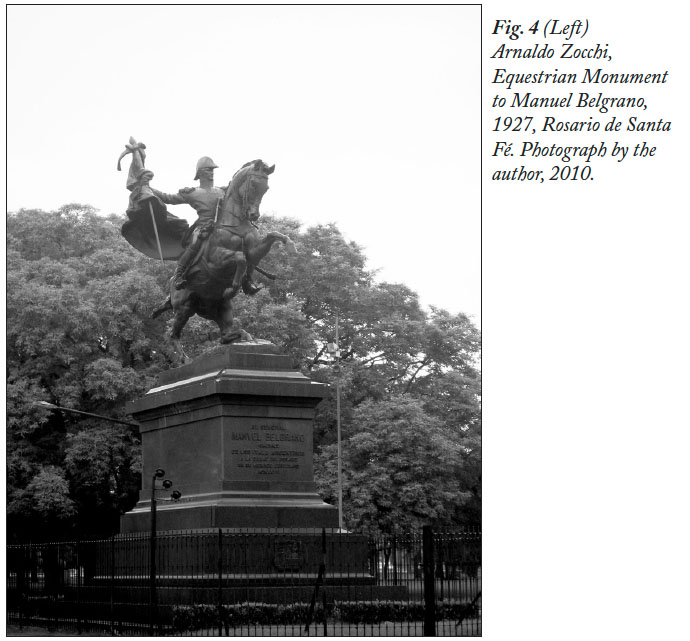 Display large image of Figure 5
Display large image of Figure 5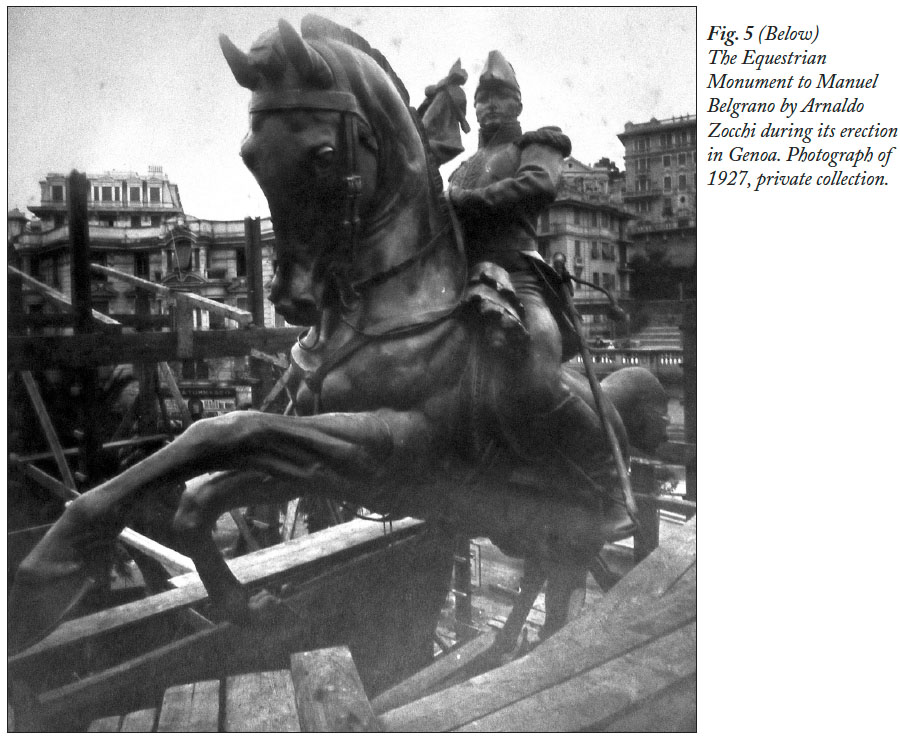 Display large image of Figure 6
Display large image of Figure 6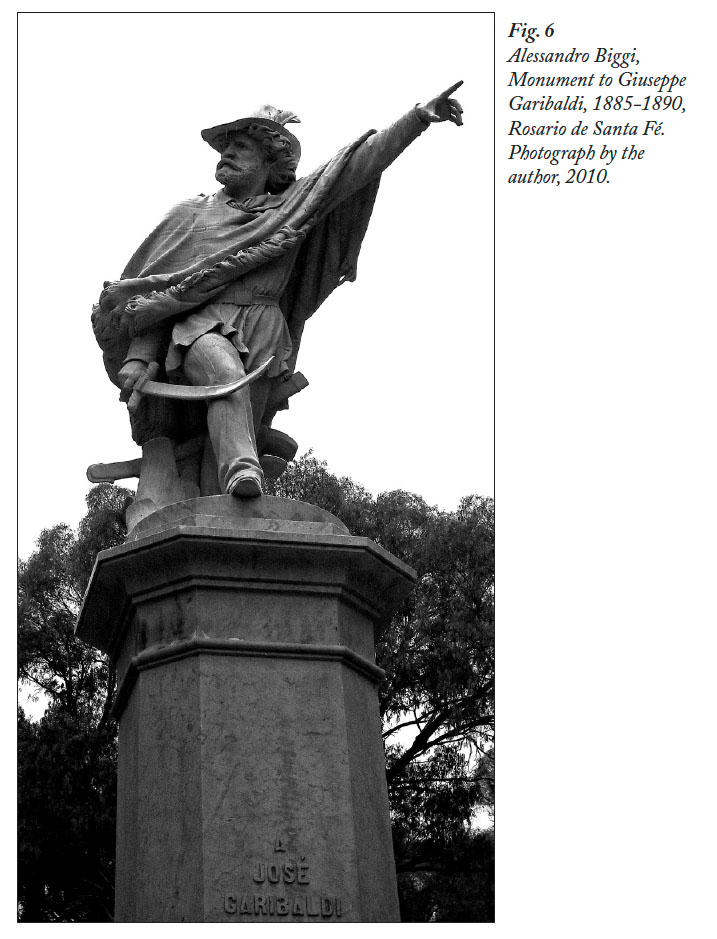 Display large image of Figure 7
Display large image of Figure 740 On the other hand, when Italo-American communities chose to erect a monument to Garibaldi, political questions were raised, as just a few decades before Garibaldi was fighting in South America as a rebel or a pirate. While in Uruguay, Garibaldi was honoured as the “hero of two worlds” by both the local government and the Italian community, in Argentina (as well as in the United States) things were rather more complicated (Gutiérrez Viñuales 2004: 241-46). Nevertheless, several monuments of him spread throughout Latin America. For example, in 1906, after having won the international competition for the monument in Buenos Aires, the Italian sculptor Eugenio Maccagnani sent his equestrian model to Berlin for melting and, from there, the statue was sent to Buenos Aires. Compared to the monument of Garibaldi previously realized by Maccagnani for the Italian city of Brescia, the statue for Buenos Aires expressed more dynamism in both the man and the horse figures. Moreover, the basement was decorated with reliefs depicting dramatic and dynamic scenes.10
41 These dynamic characteristics of Garibaldi’s monuments had already been used in a nearby context. In 1885, the Carrara sculptor Alessandro Biggi completed the marble works which form the monument to Garibaldi for the city of Rosario de Santa Fé.11 The figure of Garibaldi is caught in a moment of action: the sword is unsheathed and thrown forward, an arm is outstretched, and the face is turned to call his companions to attack (Fig. 6). Moreover, Garibaldi is dressed in a very Latin American poncho and hat. In Latin America, the figure of Garibaldi looks increasingly like that of a gaucho, and we find this new identity readapted for some Italian monuments. In Carrara, where Biggi was living and working, Carlo Nicoli created a monument to Garibaldi that appears similar to the one created by Biggi for the city of Rosario de Santa Fé.
42 The phenomenon of the international success of particular models or iconography characterizes not only the public patronage but also, and even more, the private clients. This often occurs in the field of funerary sculpture, which, in the 19th century, went through a moment of unique prosperity. In 1894, William Wetmore Story, a North American sculptor living in Rome, made a striking work for his wife’s tomb in the non-Catholic cemetery of the town. The marble figure of an angel kneeling and surrendering itself on the grave, its face in its arms, its wings drooping to the ground, conveys a sense of sadness and sweetness (Fig. 7a-b). It did not take long before the image of that Angel of Grief, admired by people visiting Rome from all the world, was printed in the books of workshops and galleries. One person who probably noticed one of these catalogues was Jane Lathrop Stanford (who together with her husband founded Stanford University) in the last years of the 19th century, when the campus was to be renewed. As the Stanfords decided to found the university to commemorate their son, who died in 1884, Jane Stanford also wanted to remember her brother with a monument in the campus. So she decided to buy a statue representing the Angel of Grief which would be made in Carrara from a unique block of marble. In 1901, Italian sculptor Antonio Bernieri made the monument in Carrara and sent it to the port of Genoa. From there, the statue was loaded onto a steamship directed to New Orleans and from there sent by train to Palo Alto.
43 However, sculptures were not always sent from Italy; some of them were also made directly in American workshops in which Italian sculptors collaborated with local artisans and artists. For this reason we can find the iconographic model of the Angel of Grief replicated in Colma, Chico, Hayward, Oakland, New Orleans, Columbus, Houston, Scottsville, New York, and St. Louis, and those in North America alone.
44 In the second half of the 19th century, in Christian funerary sculpture, the traditional iconography seemed to be partially replaced by a progressive secularization of symbols. In this context, though the figure of an angel still represented a creature connected to the Christian tradition, it seemed to lose fundamental traits such as consolation and reassurance. As Sborgi points out,
Among the earliest examples of these kinds of angels is the statue that Giulio Monteverde made in 1882 for the tomb of the rich merchant Francesco Oneto in the Genoese cemetery of Staglieno (Fig. 8). Monteverde conceived an image representing both an angel of the Judgement Day and “an angel of a feminine type which, for the first time, was explicitly sensual, an embodiment of the conjunction of Eros and Thanatos” (Sborgi 2004: 208-209). Before long, the icon created by Monteverde became a sort of standard model for the representation of the mystery of death all over the Western world. Research has demonstrated its diffusion in European cemeteries (from Romania to Spain, from France to England) as well as in those of both North and South America (Sborgi 1997: 319-31; Bochicchio 2011; Lecci 2012). The dynamics of such an incredible diffusion are quite complicated. In some cases, clients ordered a copy of the statue directly from Giulio Monteverde, who in that period was very well known, especially by European sovereigns and ambassadors, as well as the upper classes.12 Alongside these reproductions, in the largest cemeteries like the Woodlawn in New York, Recoleta and Chacarita in Buenos Aires (Fig. 9), Colón in La Habana, and Buceo in Montevideo, several adapted iconographies of the Angel of Judgment also appear. They are not necessarily big marble reproductions. Sometimes only the intense gaze and face of the angel are maintained, and a sword, a palm branch, or a cross is added. Sometimes feminine angels of lesser quality with crossed arms and legs are copied. This is the sign of another phenomenon characterizing that period: the international change of taste, which was increasingly oriented toward symbolist icons. From the end of the 19th century, the artistic landscape of Latin American cemeteries became similar to the monumental cemetery of Milan, which is characterized by a strong presence of symbolist artworks. American cemeteries quickly became the core of a production system of sculpture which comprises European sculptors as well as new generations of American sculptors.
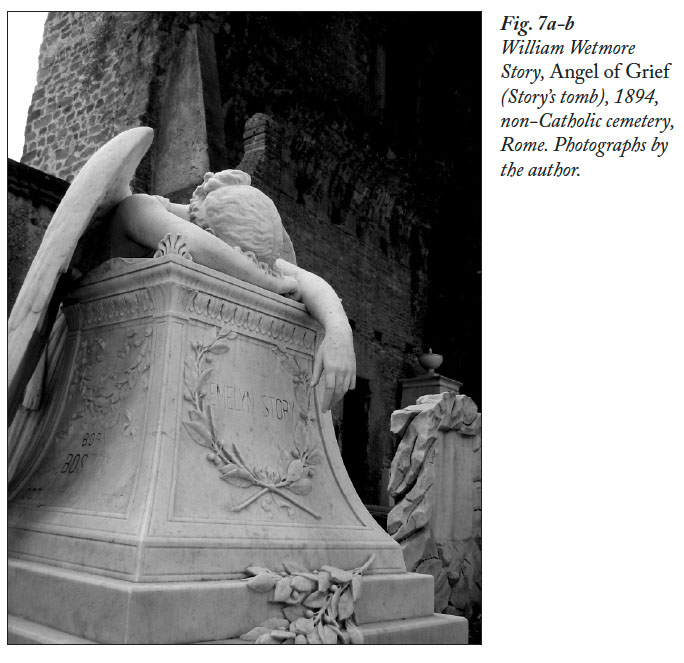 Display large image of Figure 8
Display large image of Figure 8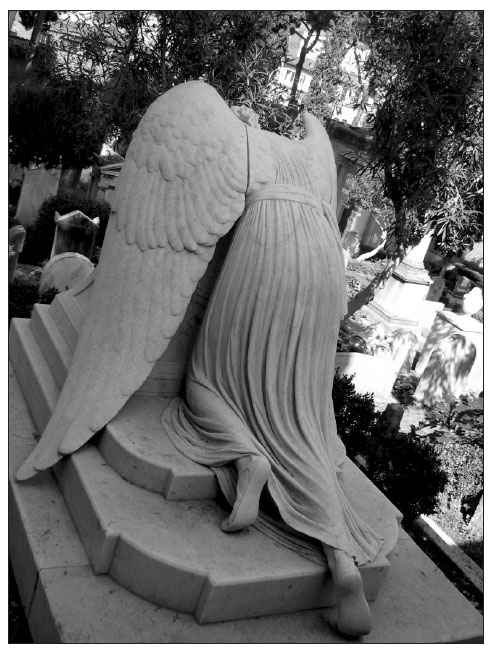 Display large image of Figure 9
Display large image of Figure 9 Display large image of Figure 10
Display large image of Figure 10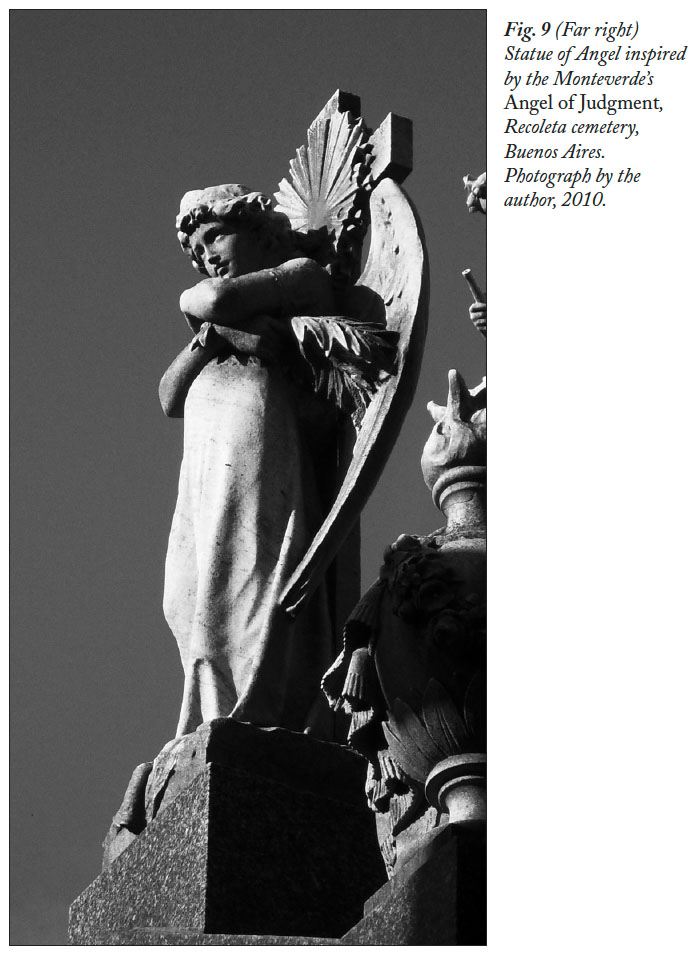 Display large image of Figure 11
Display large image of Figure 1145 Before concluding this paper it is important to stress the importance of exhibitions for the international circulation of sculpture. Universal exhibitions and artistic expositions encouraged the creation of public monuments and decorative and funerary sculptures. In the Universal Exhibition of Paris 1867, the Italian sculptor Vincenzo Vela exhibited his Columbus Discovering America. The French Empress Eugenia de Montijo bought the artwork and donated it as a public monument for the Isthmus of Panama.
46 In 1903 Juan Ramon Bonilla, a young sculptor from Costa Rica, went to the Academy of Rome after a stay in Carrara. In Rome, Bonilla attended the courses of Ettore Ferrari. A lay allegory of the maternity made in marble by the Latin American sculptor was bought by the Municipality of San José, capital of Costa Rica, and exhibited permanently in the National Theatre. During the 79th International Exhibition of Rome, Bonilla was awarded the gold medal for another sculpture: El Caminante.
47 In 1905, the Italian private gallery Stefani exhibited in its branches of Buenos Aires, Valparaiso, and Rio de Janeiro the Acquaiolo,a small bronze by Vincenzo Gemito (Fig. 10). José C. Paz bought another version 13 of the same work and donated it to the city of Buenos Aires as a public decorative statue for the park of the botanical gardens. This happened in 1911, when the capital of Argentina was still benefitting from the urban modernization for the centennial of the national independence.
Conclusions
48 In this paper we have seen that both the diffusion and the identity of 19th-century sculpture is closely connected to a wide range of factors of material and social culture. However, perhaps the last examples mentioned represent the most important and evident effects determined by the international success of Italian sculpture in America. Civil and religious monuments in countries from Argentina to Canada demonstrate the incredible cultural heritage created in the 1800s by Italy, France, and Spain. However, this sort of cultural “supremacy” was not actually the result of a simple transferring of models and artworks, and neither was it just an effect of neo-colonialism; it was the consequence of a favourable situation in which different cultures, abilities, and technologies of Europe and America met. The wide exchange and hybridization of iconologies, languages, and materials in artwork testify that both American and Italian people were changed from that relationship.
49 As in other important moments of history (e.g., the Renaissance and neoclassicism) and, even more, between the 19th and 20th century, the passage of artworks and artists between different continents was a major factor of the construction of a common identity. The presence of a dynamic international artistic network in America facilitated the approaching of different cultures to one another. For these reasons, studying and detecting the presence of Italian sculpture in America in that period is important for preserving and restoring today that common artistic heritage. Moreover, public monuments and decorative sculptures, as well as statues conserved in American public museums and collections, allow us to understand the ways in which urban spaces and modern Western society were implementing sharing ideals, lifestyles, economic, and cultural activities. It is possible that the close connection between art and economy in the 19th century, in which the number American public sculptures increased, represents one of the most important lessons we can learn.
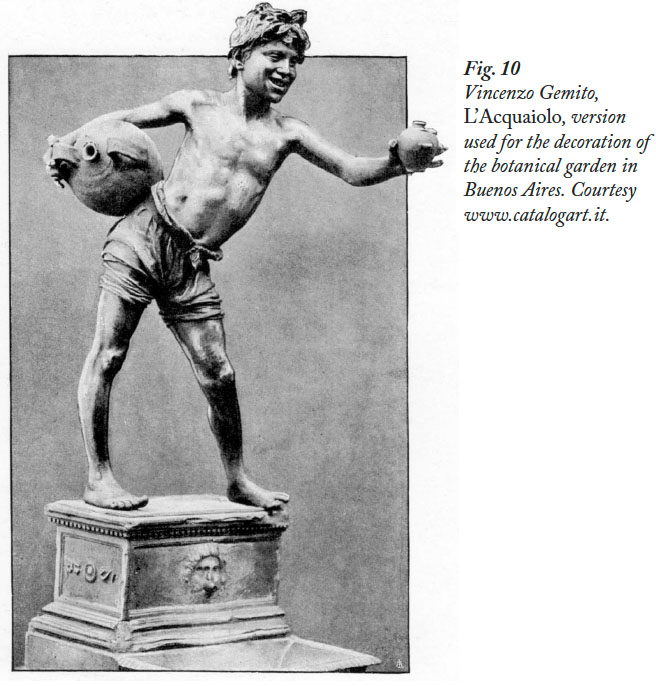 Display large image of Figure 12
Display large image of Figure 12